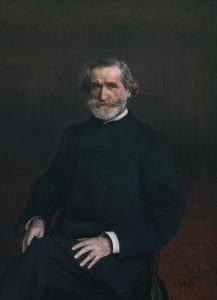
By Robert Croan
You don’t have to be Christian, or even religious, to appreciate Giuseppe Verdi’s magnificent Requiem. The composer himself was essentially agnostic – something more significant when the work was composed in 1874, than it would be today. The effect of this great masterpiece for double choirs, four soloists and large orchestra, commemorating the death of Italian author Alessandro Manzoni, is more operatic than liturgical. And ultimately, very uplifting.
Verdi’s approximately 90-minute setting of the Latin Mass for the Dead contains all the drama and theatricality of Aida or Otello, the operas by Verdi that preceded and followed its premiere – minus, of course, scenery, costumes or a plot. Numerous composers have created concert versions of the Requiem texts, but none has the immediacy and theatricality of Verdi’s monumental mini-opera.
Verdi’s Requiem is as ambitious a project as a community choral group can undertake, and the Master Chorale of South Florida, performing March 30 in The Parker (followed by two concerts in Boca Raton) more than met the challenge. With the mostly student (and very accomplished) Lynn University Philharmonia Orchestra and a splendid professional solo quartet under artistic director and conductor Brett Karlin, the Master Chorale provided one of the most satisfying classical music events I can recall in a decade of South Florida concert going. It was especially useful to have the English translations of the texts projected in supertitles.
Whether it was the repose and comfort demanded by the sustained soft passages of the opening “rest eternally” sentiment, the soaring soloists in the “Kyrie eleison” or the blasting brasses and pounding timpani of the “day of wrath” – these contrasting emotions are all recurring motives throughout the piece – the Master Chorale singers filled the bill, with right-on intonation and verbal clarity. Just staying in tune for the a cappella repeat of the “Requiem” words near the end, with the soprano soloist floating softly above in her highest range, is a major feat, as were the complexities of the double chorus “Sanctus,” at the other end of the volume spectrum.
As for the solo quartet, this work demands voice types that might form the nucleus of an Aida cast (Aida, Amneris, Radames, Ramfis). Soprano Robyn Marie Lamp soared opulently in the opening “Kyrie,” later diminishing to the above-mentioned pianissimi. Mezzo-soprano Lindsay Kate Brown joined her admirably in the melodic “Recordare,” elsewhere producing some ferocious chest tones when the text required them for impact. If these two voices didn’t quite blend in the very difficult octave declamation of “Agnus Dei,” that was a small flaw in a massive achievement.
Most impressive among the soloists was tenor Arturo Chacón-Cruz, a Miami resident who was concurrently performing as Cavaradossi in Florida Grand Opera’s production of Puccini’s Tosca. Midway through the Requiem, after negotiating his lines mellifluously in the opening movements, Chacón-Cruz put aside his score and came forward to deliver his big moment – “Ingemisco” – with a directness and sincerity that made it seem he was pointing his lines to each individual listener. Those phrases range from infinite sadness to a stentorian ascending octave-scale climax that depicts being seated “at the right hand of God.” This very appealing artist tossed it all off as if it were simple and natural.
The tenor’s aria was followed by the only other excerptable solo in this work, the bass’s thunderous “Confutatis,” rendered with strong, deep tones and a sense of urgency by Richard Ollarsaba, interrupted on the last chord by a rousing repeat of the choir’s “Dies irae.”
In contrast, the Offertory section contains some of this Requiem’s most moving, contemplative passages – notably the “Hostias,” scored for all four soloists, its haunting melody exhorted first by the tenor, then the bass, each segment brought to life with expert legato and even the hint of a trill (not easy for the male voices) at the cadence.
A morsel of trivia for the curious-minded: While it’s uncommon for Requiem masses to find their way into pop culture, a fragment of the “Dies irae” was used by the British boy band Take That in their 1995 hit song, “Never Forget.” You can check it out on YouTube.